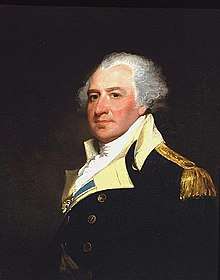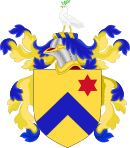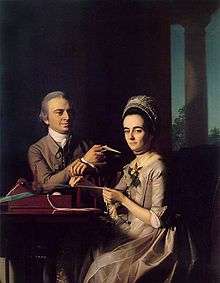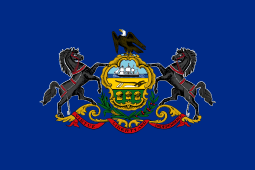Thomas Mifflin
Thomas Mifflin (January 10, 1744 – January 20, 1800) was an American merchant, soldier, and politician from Philadelphia, Pennsylvania. He served in a variety of roles during and after the American Revolution, several of which qualify him to be counted among the Founding Fathers. He was the first Governor of Pennsylvania, serving from 1790 to 1799; he was also the last President of Pennsylvania, succeeding Benjamin Franklin and serving from 1788 until 1790.
Thomas Mifflin | |
|---|---|
 | |
| 1st Governor of Pennsylvania | |
| In office December 21, 1790 – December 17, 1799 | |
| Preceded by | Himself as President of Pennsylvania |
| Succeeded by | Thomas McKean |
| 7th President of Pennsylvania | |
| In office November 5, 1788 – December 21, 1790 | |
| Vice President | George Ross |
| Preceded by | Benjamin Franklin |
| Succeeded by | Himself as Governor of Pennsylvania |
| Speaker of the Pennsylvania House of Representatives | |
| In office 1785–1787 | |
| Preceded by | John Bayard |
| Succeeded by | Richard Peters |
| 3rd President of the Confederation Congress | |
| In office November 3, 1783 – June 3, 1784 | |
| Preceded by | Elias Boudinot |
| Succeeded by | Richard Henry Lee |
| Continental Congressman | |
| In office 1782–1784 | |
| In office 1774–1775 | |
| Personal details | |
| Born | January 10, 1744 Philadelphia, Province of Pennsylvania, British America |
| Died | January 20, 1800 (aged 56) Lancaster, Pennsylvania, U.S. |
| Political party | Federalist |
| Spouse(s) | Sarah Morris
( m. 1767; died 1790) |
| Profession | Merchant, soldier, politician |
| Signature | |
Born in Philadelphia, Mifflin became a merchant after graduating from the College of Philadelphia. He joined the Continental Army after serving in the Pennsylvania Provincial Assembly and the Continental Congress. During the American Revolutionary War, he was an aide to General George Washington and the Continental Army's Quartermaster General, rising to the rank of major general. Mifflin returned to Congress in 1782 and was elected President of the Continental Congress in 1783. He served as Speaker of the Pennsylvania House of Representatives from 1785 to 1787, then as President of the Pennsylvania Supreme Executive Council from 1788 to 1790.
Mifflin was a delegate to the 1787 Philadelphia Convention and signed the United States Constitution. He then presided over the committee that wrote Pennsylvania's own constitution and he became the first governor after the ratification of the constitution. Mifflin left office as governor in 1799, and died the following year.
Early life and family

Thomas Mifflin was born January 10, 1744 in Philadelphia in the Province of Pennsylvania. He was the son of John Mifflin and Elizabeth Bagnall. His great-grandfather John Mifflin Jr. (1661–1714) was born in Warminster, Wiltshire, England and settled in the Province of Pennsylvania.[2]
In 1760, Thomas Mifflin graduated from the College of Philadelphia (now the University of Pennsylvania) and joined the mercantile business of William Biddle. After returning from a trip to Europe in 1765, he established a commercial business partnership with his brother, George Mifflin.
He married a second cousin, Sarah Morris, on March 4, 1767.[3] They had no children.[3]
Military service during the American Revolution

Early in the Revolutionary War, Mifflin left the Continental Congress to serve in the Continental Army. He was commissioned as a major, then became an aide-de-camp of George Washington.
On August 14, 1775, Washington appointed him to become the army's first Quartermaster General, under order of Congress.[5] Although it has been said that he was good at the job despite preferring to be on the front lines, questions were raised regarding his failure to properly supply Washington and the troops at Valley Forge, alleging that he had instead warehoused and sold supplies intended for Valley Forge to the highest bidder. Reportedly, after Washington confronted him about this,[6] Mifflin asked to be relieved as Quartermaster General, but was persuaded to resume those duties because Congress was having difficulty finding a replacement.
Mifflin's leadership in the Battle of Trenton and the Battle of Princeton led to a promotion to major general.[7]
In Congress, there was debate regarding whether a national army was more efficient or whether the individual states should maintain their own forces. As a result of this debate the Congressional Board of War was created, on which Mifflin served from 1777 to 1778. He then rejoined the army but took little active role, following criticism of his service as quartermaster general. He was accused of embezzlement and welcomed an inquiry; however, one never took place. He resigned his commission—by then, as a major general—but Congress continued to ask his advice even after accepting his resignation.
Political career

Prior to American independence, Thomas Mifflin was a member of the Pennsylvania Provincial Assembly (1772–1776). He served two terms in the Continental Congress (1774–1775 and 1782–1784), including seven months (November 1783 to June 1784) as that body's presiding officer.
Mifflin's most important duty as president was to accept on behalf of Congress the resignation of General George Washington on December 23, 1783. After the war, the importance of Congress declined so precipitously that Mifflin found it difficult to convince the states to send enough delegates to Congress to ratify the Treaty of Paris, which finally took place on January 14, 1784 at the Maryland State House in Annapolis.[9] He also appointed Thomas Jefferson as a minister to France on May 7, 1784, and he appointed his former aide, Colonel Josiah Harmar, to be the commander of the First American Regiment.
Mifflin later served as a delegate to the United States Constitutional Convention in 1787. He was a signatory to the Continental Association and the Constitution.[10] He served in the house of Pennsylvania General Assembly (1785–1788). He was a member of the Supreme Executive Council of the Commonwealth of Pennsylvania, and on November 5, 1788, he was elected President of the Council, replacing Benjamin Franklin. He was unanimously reelected to the Presidency on November 11, 1789.[11] He presided over the committee that wrote Pennsylvania's 1790 State Constitution. That document did away with the Executive Council, replacing it with a single governor.
On December 21, 1790, Mifflin became the last President of Pennsylvania and the first Governor of the Commonwealth. He held the latter office until December 17, 1799,[10] when he was succeeded by Thomas McKean. He then returned to the state legislature, where he served until his death the following month.
Personal life

Although Mifflin's family had been Quakers for four generations, he was expelled from the Religious Society of Friends when he joined the Continental Army, because his involvement with the military contradicted that faith's pacifistic doctrines.[12]
Mifflin became a member of the American Philosophical Society in 1768, and served for two years as its secretary.[7]
He served from 1773 to 1791 as a trustee of the College and Academy of Philadelphia (now the University of Pennsylvania), including two years as treasurer (1773–1775).[13]
Death and legacy
Mifflin died in Lancaster, Pennsylvania on January 23, 1800.[7] He is interred at Holy Trinity Lutheran Church in Lancaster.[14]
A Commonwealth of Pennsylvania historical marker outside Holy Trinity, dedicated in 1975, commemorates Thomas Wharton and Mifflin, the first and last Presidents of Pennsylvania under the Pennsylvania Constitution of 1776. It reads:
Holy Trinity Lutheran Church. Founded in 1730. A session for an Indian treaty was held in the original church building in 1762. The present edifice was dedicated in 1766. Here are interred the remains of Thomas Wharton (1778) and Gov. Thomas Mifflin (1800).[15]
Mifflin eponyms
Counties, cities, and townships
- Fort Mifflin, Philadelphia County, Pennsylvania
- Mifflin, Pennsylvania
- Mifflin County, Pennsylvania
- Mifflin Cross Roads, Pennsylvania
- Mifflin Township, Dauphin County, Pennsylvania
- Mifflin Township, Lycoming County, Pennsylvania
- Mifflinburg, Pennsylvania
- Mifflintown, Pennsylvania
- Mifflinville, Pennsylvania
- Upper Mifflin Township, Cumberland County, Pennsylvania
- West Mifflin, Pennsylvania[16]
Schools and government buildings
- Governor Mifflin School District
- Mifflin Hall (dormitory at the Pennsylvania State University University Park Campus)[17]
- Mifflin Hall (main building at the U.S. Army Quartermaster Center and School at Fort Lee, Virginia)[18]
- Thomas Mifflin School, School District of Philadelphia
Footnotes
- Bolton, Charles Knowles (1927). Bolton's American Armory (2009 reprint ed.). Boston: F.W. Faxon Co. p. 115. ISBN 978-0806300443. Note that the following warning about authenticity appears in the introduction: "Readers whose chief interest is in 'authentic' arms... must look elsewhere." (Introduction, p. ix).
- "John Mifflin, II". Geni. Retrieved September 19, 2015.
- Egle, William Henry (1898). Some Pennsylvania Women During the War of the Revolution. Excerpt at Klos, Stanley. "Sarah Morris Mifflin". ThomasMifflin.com.
- Caldwell, John; Rodriguez Roque, Oswaldo (1994). "Thomas Mifflin". American Paintings in The Metropolitan Museum of Art. 1. The Metropolitan Museum of Art. pp. 214–15.
- Risch, Erna (1981). Supplying Washington's Army. Washington, D.C.: U.S. Army Center of Military History. pp. 30–31.
- Unger, Harlow Giles (2010). Patrick Henry, Lion of Liberty. Da Capo Press.
- Wright, Robert K., Jr.; MacGregor, Morris J., Jr. (1987). "Thomas Mifflin". Soldier-Statesmen of the Constitution. U.S. Army Center of Military History. pp. 109–11.
- "General George Washington Resigning His Commission". Architect of the Capitol.
- Alexander, John K. (February 2000). "Mifflin, Thomas". American National Biography Online. Missing or empty
|url=(help) - "Thomas Mifflin". Pennsylvania Historical and Museum Commission. Archived from the original on November 4, 2001.CS1 maint: unfit url (link)
- Minutes of the Supreme Executive Council of Pennsylvania, from its organization to the termination of the Revolution. [March 4, 1777 – December 20, 1790]. Harrisburg: Commonwealth of Pennsylvania. 1852–53.
- "Thomas Mifflin". Adherents.com. Citing Ferris, Robert G., ed. (1976). Signers of the Constitution: Historic Places Commemorating the Signing of the Constitution (revised ed.). Washington, DC: U.S. Department of the Interior, National Park Service. pp. 193–94.
- "Thomas Mifflin (1744–1800)". Penn in the 18th Century. University of Pennsylvania. Archived from the original on April 23, 2018.
- United States Congress. "Thomas Mifflin". Biographical Directory of the United States Congress.
- "Thomas Mifflin", Pennsylvania State Historical Marker. Archived May 26, 2008, at the Wayback Machine
- Ackerman, Jan (May 10, 1984). "Town names carry bit of history". Pittsburgh Post-Gazette. p. 6. Retrieved October 31, 2015.
- "History of Mifflin Hall". Pennsylvania State University. Retrieved May 31, 2010.
- "History of Quartermaster Center, Fort Lee, Virginia". Archived from the original on September 7, 2012. Retrieved May 31, 2010..
References
- Boatner, Mark M. III (1974). Encyclopedia of the American Revolution. New York: David McKay Company, Inc. ISBN 978-0679504405.
- Rossum, Kenneth R. (1952). Thomas Mifflin and the Politics of the American Revolution. Chapel Hill: University of North Carolina Press.
- Rowe, G. S. (1978). Thomas Mifflin: The Shaping of an American Republican. Boulder: University of Colorado Press.
- Taffe, Stephen R. (2003). The Philadelphia Campaign 1777–1778. Lawrence: University Press of Kansas. ISBN 978-0700612673.
- Tinckom, Harry M. (1950). The Republicans and Federalists in Pennsylvania. Harrisburg: Pennsylvania Historical and Museum Commission. pp. 113–34.
External links
| Wikimedia Commons has media related to Thomas Mifflin. |
- Brief biography and portrait at the University of Pennsylvania
- Biography and portrait at Quartermasters-General
| Party political offices | ||
|---|---|---|
| First | Democratic-Republican nominee for Governor of Pennsylvania 1790, 1793, 1796 |
Succeeded by Thomas McKean |
| Political offices | ||
| Preceded by Elias Boudinot |
President of the United States in Congress Assembled November 3, 1783 – October 31, 1784 |
Succeeded by Richard Henry Lee |
| Preceded by Benjamin Franklin |
President of Pennsylvania November 5, 1788 – December 21, 1790 |
Office abolished Became Governor of Pennsylvania |
| New office Previously President of Pennsylvania |
Governor of Pennsylvania December 21, 1790 – 1799 |
Succeeded by Thomas McKean |
| Legal offices | ||
| Preceded by Henry Hill |
Member, Supreme Executive Council of Pennsylvania, representing the County of Philadelphia October 20, 1788 – December 21, 1790 |
Office abolished |


